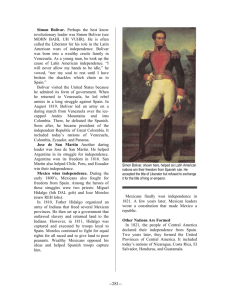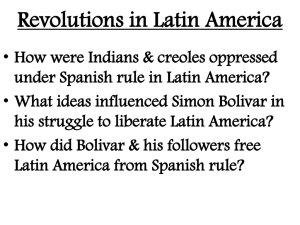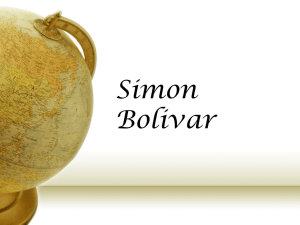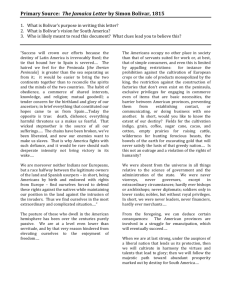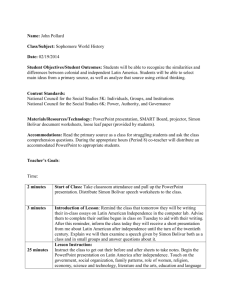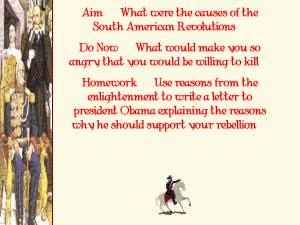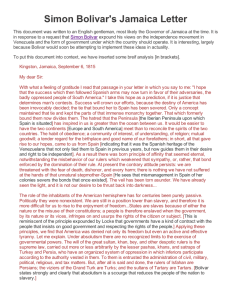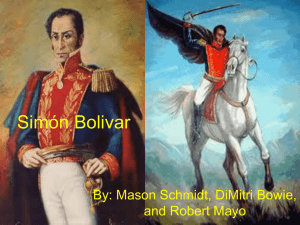Bolivar DBQ
advertisement
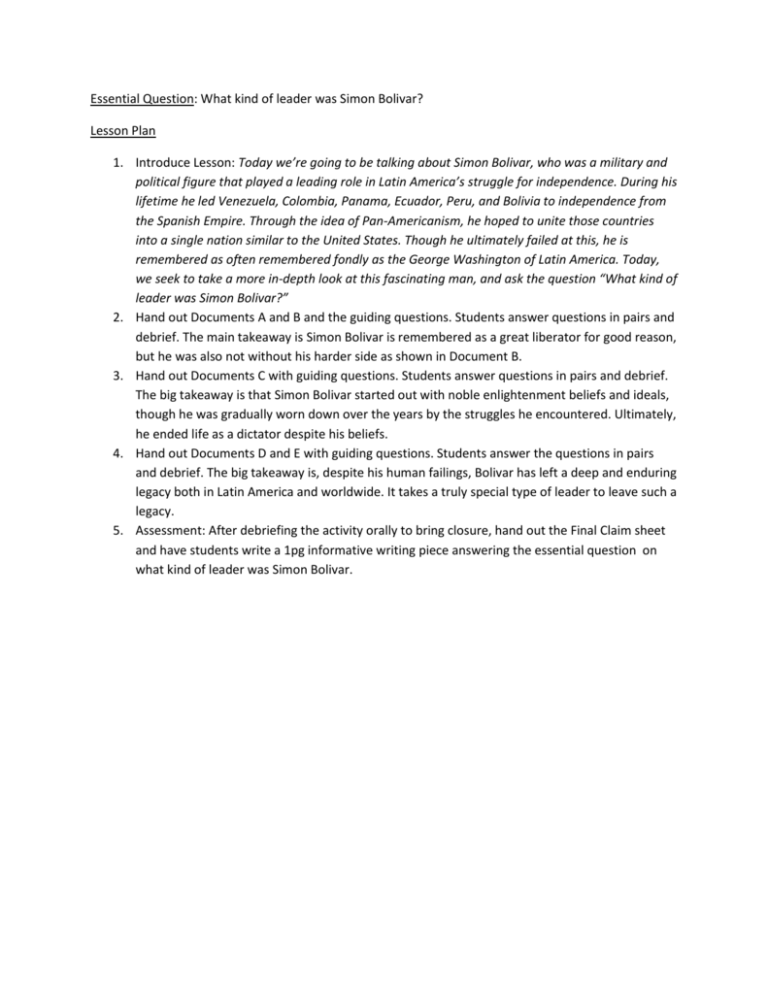
Essential Question: What kind of leader was Simon Bolivar? Lesson Plan 1. Introduce Lesson: Today we’re going to be talking about Simon Bolivar, who was a military and political figure that played a leading role in Latin America’s struggle for independence. During his lifetime he led Venezuela, Colombia, Panama, Ecuador, Peru, and Bolivia to independence from the Spanish Empire. Through the idea of Pan-Americanism, he hoped to unite those countries into a single nation similar to the United States. Though he ultimately failed at this, he is remembered as often remembered fondly as the George Washington of Latin America. Today, we seek to take a more in-depth look at this fascinating man, and ask the question “What kind of leader was Simon Bolivar?” 2. Hand out Documents A and B and the guiding questions. Students answer questions in pairs and debrief. The main takeaway is Simon Bolivar is remembered as a great liberator for good reason, but he was also not without his harder side as shown in Document B. 3. Hand out Documents C with guiding questions. Students answer questions in pairs and debrief. The big takeaway is that Simon Bolivar started out with noble enlightenment beliefs and ideals, though he was gradually worn down over the years by the struggles he encountered. Ultimately, he ended life as a dictator despite his beliefs. 4. Hand out Documents D and E with guiding questions. Students answer the questions in pairs and debrief. The big takeaway is, despite his human failings, Bolivar has left a deep and enduring legacy both in Latin America and worldwide. It takes a truly special type of leader to leave such a legacy. 5. Assessment: After debriefing the activity orally to bring closure, hand out the Final Claim sheet and have students write a 1pg informative writing piece answering the essential question on what kind of leader was Simon Bolivar. “El Libertador” (Document A) Source: The following portrait was painted by Tito Salas in 1930. The painting is titled “El Libertador,”which means “The Liberator.” Proclamation of 1813 (Document B) Source: Venezuela declared its independence from Spain in 1811. However, Spain regained control of the country by July of 1812. Simon Bolivar was chosen to lead an army to drive the Spanish out of Venezuela for a second time. He gave this speech on June 15, 1813 to Venezuelans in the city of Trujillo. An army of our brothers has come to liberate you. We are sent to destroy the Spaniards, to protect the Americans, and to reestablish the republican governments of Venezuela. The states defended by our arms are again governed by their former constitutions, in full enjoyment of their liberty and independence. Our mission is designed only to break the chains of servitude which shackle (chain up) some of our towns, and not to impose laws or carry out acts of dominion (conquest). We have been unable to watch with indifference the afflictions (hurts) you were forced to experience by the barbarous Spaniards. They have plundered (robbed) you, and brought you death and destruction. Justice demands vengeance, and necessity requires us to take it. Let the monsters who infest Colombian soil be cast out forever. May their punishment be equal to the size of their perfidy (treachery), so that we may demonstrate to the nations of the world that the sons of America cannot be offended without consequences. Despite our just resentment (hatred) toward the Spaniards, our generous heart still commands us to open to them a path to friendship. They are invited to live peacefully among us, if they will renounce (speak against) their crimes, honestly change their ways, and cooperate with us in destroying the invading Spanish government. Any Spaniard who does not will be considered an enemy and punished. As a traitor to the nation, he will be shot by a firing squad. And you Americans who, by error or treachery, have been lured from the path of justice, are informed that your brothers have pardoned (forgiven) you. Only the blindness and ignorance in which you have been kept up to now by those truly responsible for your crimes could have caused you to commit them. Our arms have come to protect you, and they shall never be raised against a single one of you, our brothers. Guiding Questions Document A (El Lbertador) 1. Close Reading: Describe the painting. What are some if the images, symbols, and characters you see? Describe AT LEAST THREE 2. Close Reading: What do you think is the overall message of this painting? Document B (Proclamation of 1813) 1. Close Reading: Why have Simon Bolivar and his army come to Venezuela? What are they going to do? What are they not going to do? Explain 2. Close Reading: How does Bolivar say he will deal with the Spanish? How will he deal with the Americans loyal to the Spanish? Do you think this policy is fair? Explain Record your first claim: Based on these documents, what kind of leader was Simon Bolivar? Scholarly Article (Document C) Source: The following excerpt is from the article Simon Bolivar and the Spanish Revolutions, written by John Lynch, professor of Latin American History at the University of London. It was published in History Today Volume 33 Issue 7 in 1983 Bolivar’s basic aim was liberty, which he described as ‘the only object worth the sacrifice of man's life'. For Bolivar liberty did not simply mean freedom from absolutist government (monarchy), but freedom from a colonial power and true independence. With liberty he wanted legal equality for all men, whatever their class, creed or color. He was a democrat and he believed that governments should be responsible to the people. 'Only the majority is sovereign (ruler)', he wrote; 'he who takes the power of the people is a tyrant'. In the later years of his life Bolivar was haunted by the specter of anarchy (chaos) in America. Spanish Americans, he lamented, were ‘seduced by freedom', each person wanting absolute (complete) power for himself and refusing to subordinate (rank lower) their own desires for the greater good. This led to civilian factions, military uprisings, and provincial rebellions. His lifelong search for a political mean now veered towards strong government. In the 1826 Bolivian constitution, the president was appointed by the legislature for life and had the right to appoint his successor. Thus, as Bolivar himself proudly said, 'elections would be avoided, which are the greatest scourge (menace) of republics and produce only anarchy'. The rest of the constitution was not devoid of liberal details. It provided for civil rights – liberty, equality, security and property – and for a strong, independent judicial power (court system). It abolished social privileges, and it declared the slaves free. But this constitution was marked by the president for life with right to choose his successor. It was this which outraged many Americans, conservatives as well as liberals. The political career of Bolivar himself, moreover, took a similar path in Colombia, as he moved from president to dictator. This was his tragedy. In spite of his preference for a political over a military solution, in spite of his long search for constitutional forms, he fell back in the end on personal authority, ruling through a dictatorship. Guiding Questions Document C (Scholarly Article) 1. Close Reading: Re-read the first paragraph. What were Simon Bolivar’s social and political goals? Explain. 2. Close Reading: What do you think Bolivar meant when he said Spanish Americans were ‘seduced by freedom’? How is this a bad thing for democracy? 3. Close Reading: Re-read the third paragraph. How does Bolivar view elections? How does this view influence what he includes in the Bolivian Constitution? 4. Close Reading: According to the author, what was the “tragedy” of Simon Bolivar? Explain. Record your second claim: Based on these documents, what kind of leader was Simon Bolivar? Venezuelan bolivar (Document D) Source: The bolivar has been the official currency of Venezuela since 1879. Below is an example of this money. As shown on the money below, Venezuela’s official name is the Bolivarian Republic of Venezuela. Statues (Document E) Source: Below is an image of a statue of Simon Bolivar that is in Paris, France. In addition to having statues in the capital cities of Colombia, Venezuela, Ecuador, Peru, Bolivia, Panama, and Argentina, Bolivar has statues dedicated to him in major cities in France, Germany, Italy, Canada, and the United States. Guiding Questions Document D (Venezuelan Bolivar) 1. Source: What country is the above currency from? What is the official name of that country? 2. Analyze: Why do you think Venezuela chose to name their currency after Simon Bolivar? What does this say about him as a leader? Document E (Statues) 1. Source: What country and city is statue pictured above from? What other countries have statues of Simon Bolivar? 2. Analyze: Why do you think countries in both Europe and North America also have statues of Simon Bolivar? What does this say about him as a leader? Record your third claim: Based on these documents, what kind of leader was Simon Bolivar? Final Claim: What kind of leader was Simon Bolivar? *Be sure to use EVIDENCE from the documents to support your claim*
